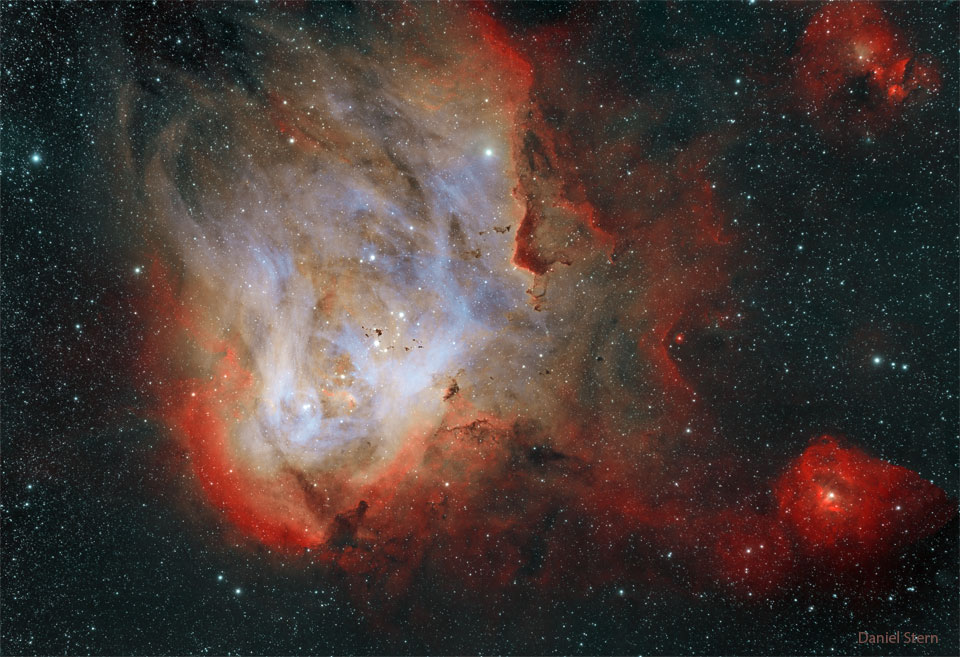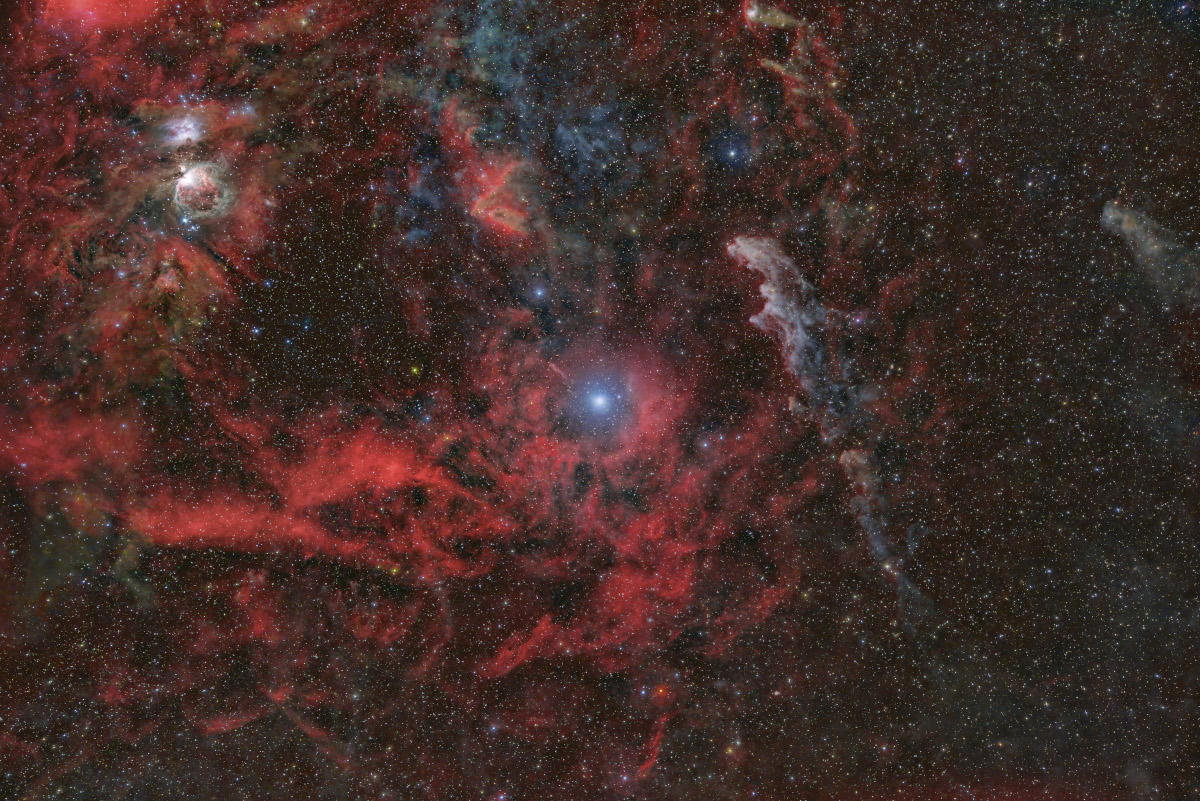Nombre total de pages vues
10/04/2023
ART FRACTAL - Fractale géométrique scintillante
ASTRONOMY - IC 2944: The Running Chicken Nebula
2023 April 10
Image Credit & Copyright: Daniel Stern
Explanation: To some, it looks like a giant chicken running across the sky. To others, it looks like a gaseous nebula where star formation takes place. Cataloged as IC 2944, the Running Chicken Nebula spans about 100 light years and lies about 6,000 light years away toward the constellation of the Centaur (Centaurus). The featured image, shown in scientifically assigned colors, was captured recently in a 16-hour exposure over three nights. The star cluster Collinder 249 is visible embedded in the nebula's glowing gas. Although difficult to discern here, several dark molecular clouds with distinct shapes can be found inside the nebula.
09/04/2023
ASTRONOMY - M100: A Grand Design Spiral Galaxy
2023 April 8
Image Credit: NASA, ESA, Hubble; Processing: Judy Schmidt
Explanation: Majestic on a truly cosmic scale, M100 is appropriately known as a grand design spiral galaxy. It is a large galaxy of over 100 billion stars with well-defined spiral arms that is similar to our own Milky Way Galaxy. One of the brightest members of the Virgo Cluster of galaxies, M100 (alias NGC 4321) is 56 million light-years distant toward the constellation of Berenice's Hair (Coma Berenices). This Hubble Space Telescope image of M100 was taken with the Wide Field Camera 3 and accentuates bright blue star clusters and intricate winding dust lanes which are hallmarks of this class of galaxies. Studies of variable stars in M100 have played an important role in determining the size and age of the Universe.
ANIMAUX NUISIBLES UTILES - L'araignée

08/04/2023
PHENOMENES ATMOSPHERIQUES - Un gigantesque anneau rouge dans le ciel a inquiété les italiens
FuturaSciences
07/04/2023
ASTRONOMIE - Magnifique tableau céleste
Positions de Vénus, Mercure et Mars le 13 avril 2023 vers 21h30 (heure de Paris).
En avril, le printemps s’installe et il est temps de dire au revoir aux constellations hivernales pour quelques mois ! Orion ou encore le Taureau sont ainsi chaque soir plus proches de l’horizon ouest et les crépuscules sont de plus en plus tardifs…
Néanmoins, ne manquez pas le charmant tableau que ces deux constellations offrent en début de nuit le 13 avril, alors que la planète Vénus s’invite dans le secteur. Brillant de mille feux et toujours immanquable, celle qu’on appelle aussi l’étoile du Berger se trouve juste entre l’amas d’étoiles bien visible des Pléiades et l’étoile orangée Aldébaran. Si vous admirez la scène avant 21h45, vous remarquerez aussi certainement la planète Mercure au ras de l’horizon et bien lumineuse. Pour compléter ce tableau planétaire, prolongez la corne inférieure du Taureau pour trouver Mars, dont l’éclat est désormais bien modeste comparé à celui de la fin 2022. À la même hauteur et à droite de la planète rouge, vous repérerez aussi sans peine l’étoile Capella.
Ce magnifique tableau céleste s’admire à l’œil nu, seul ou à plusieurs, pourquoi pas avec les enfants. Mais si vous souhaitez utiliser une paire de jumelles, pointez-les vers le splendide couple Vénus-Pléiades, bien visibles ensemble dans cet instrument.
Stelvision
ASTRONOMY - Rigel Wide
2023 April 7
Image Credit: Rheinhold Wittich
Explanation: Brilliant, blue, supergiant star Rigel marks the foot of Orion the Hunter in planet Earth's night. Designated Beta Orionis, it's at the center of this remarkably deep and wide field of view. Rigel's blue color indicates that it is much hotter than its rival supergiant in Orion the yellowish Betelgeuse (Alpha Orionis), though both stars are massive enough to eventually end their days as core collapse supernovae. Some 860 light-years away, Rigel is hotter than the Sun too and extends to about 74 times the solar radius. That's about the size of the orbit of Mercury. In the 10 degree wide frame toward the nebula rich constellation, the Orion Nebula is at the upper left. To the right of Rigel and illuminated by its brilliant blue starlight lies the dusty Witch Head Nebula. Rigel is part of a multiple star system, though its companion stars are much fainter.
06/04/2023
ASTRONOMY - Terran 1 Burns Methalox
2023 April 6
Image Credit: Relativity / John Kraus
Explanation: Relativity's Terran 1 Rocket is mostly 3D-printed. It burns a cryogenic rocket fuel composed of liquid methane and liquid oxygen (methalox). In this close-up of a Terran 1 launch on the night of March 22 from Cape Canaveral, icy chunks fall through the stunning frame as intense blue exhaust streams from its nine Aeon 1 engines. In a largely successful flight the inovative rocket achieved main engine cutoff and stage separation but fell short of orbit after an anomaly at the beginning of its second stage flight. Of course this Terran 1 rocket was never intended to travel to Mars. Still, the methane and liquid oxygen components of its methalox fuel can be made solely from materials found on the Red Planet. Methalox manufactured on Mars could be used as fuel for rockets returning to planet Earth.
04/04/2023
ASTRONOMIE - Collision spectaculaire entre deux galaxies
ASTRONOMY - Olympus Mons: Largest Volcano in the Solar System
2023 April 4
Image Credit: ESA, DLR, FU Berlin, Mars Express; Processing & CC BY 2.0 License: Andrea Luck
Explanation: The largest volcano in our Solar System is on Mars. Although three times higher than Earth's Mount Everest, Olympus Mons will not be difficult for humans to climb because of the volcano's shallow slopes and Mars' low gravity. Covering an area greater than the entire Hawaiian volcano chain, the slopes of Olympus Mons typically rise only a few degrees at a time. Olympus Mons is an immense shield volcano, built long ago by fluid lava. A relatively static surface crust allowed it to build up over time. Its last eruption is thought to have been about 25 million years ago. The featured image was taken by the European Space Agency's robotic Mars Express spacecraft currently orbiting the Red Planet.
ASTRONOMY - The Surface of Titan from Huygens
2025 November 30 The Surface of Titan from Huygens Image Credit: ESA , NASA , JPL , U. Arizona , Huygens Lander Explanation: If you c...

-
2022 September 26 All the Water on Planet Earth Illustration Credit: Jack Cook, Adam Nieman, Woods Hole Oceanographic Institution ; Data ...
-
2025 May 11 The Surface of Venus from Venera 14 Image Credit: Soviet Planetary Exploration Program , Venera 14 ; Processing & Copyri...







